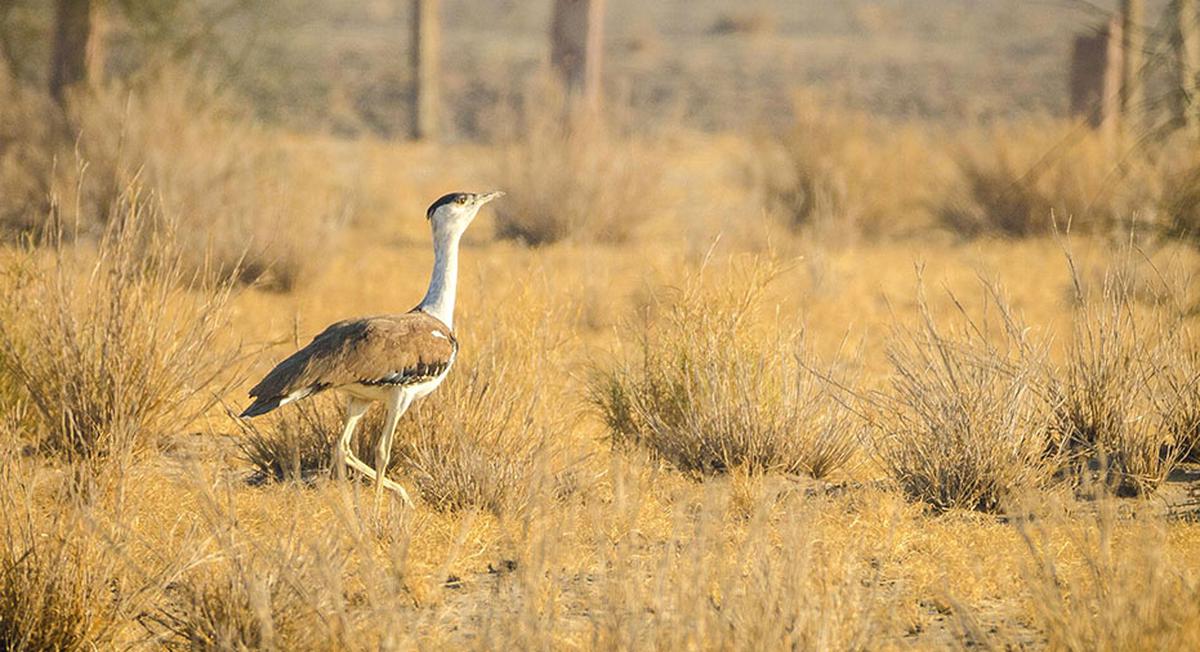Context
-
Hearing a plea to protect the endangered bird Great Indian Bustard (GIB), the Supreme Court asked if a ‘Project Great Indian Bustard (GIB)’, on the lines of ‘Project Tiger’, could be launched.
What is the Great Indian Bustard?
- This large bird, found mainly in Rajasthan and Gujarat, has been categorised as critically endangered by the International Union for Conservation of Nature (IUCN).


Photo Credit: The Hindu (Special Arrangement) - While the GIBs’ historic range included much of the Indian sub-continent, it has now shrunk to just 10 per cent of that.
- Among the heaviest birds with flight, GIBs prefer grasslands as their habitats.
- The terrestrial birds spend most of their time on the ground, feeding on insects, lizards, grass seeds, etc.
- GIBs are considered the flagship bird species of grassland and hence barometers of the health of grassland ecosystems.
- GIBs are the largest among the four bustard species found in India, the other three being MacQueen’s bustard, lesser florican and the Bengal florican.
Why is the Great Indian Bustard endangered?
- Among the biggest threats to the GIBs are overhead power transmission lines. Due to their poor frontal vision, the birds can’t spot the power lines from a distance, and are too heavy to change course when close.
- Thus, they collide with the cables and die.
- According to the Wildlife Institute of India (WII), in Rajasthan, 18 GIBs die every year after colliding with overhead power lines.
- The GIBs are not great fliers and have wide sideways vision to maximise predator detection but the species’ frontal vision is narrow. These birds cannot detect power lines from far and since they are heavy fliers, they fail to manoeuvre across power lines within close distances. The combination of these traits makes them vulnerable to collision with power lines. In most cases, death is due to collision rather than electrocution.
Great Indian Bustard: Conservation efforts
- The Supreme Court in April 2021 ordered that all overhead power transmission lines in core and potential GIB habitats in Rajasthan and Gujarat should be made underground.
- Kutch Bustard Sanctuary (KBS) in Gujarat’s Kutch district is a tiny sanctuary notified in 1992 and spread over just two square kilometres (sqkm). But its eco-sensitive zone spread over 220 sqkm covers most of present-day core GIB habitat. The creation of safe-haven for the birds led to an increase in the GIB population.
- Besides the KBS, Prajau, Bhanada and Kunathia-Bhachunda are important grasslands which have been declared unclassified forests recently. Due to the barrier created by the power infrastructure on all its sides, sightings of GIB inside the KBS’ notified two sqkm area is becoming increasingly rare.
- Listed in Schedule I of the Indian Wildlife (Protection) Act, 1972, in Appendix I of CITES, as Critically Endangered on the IUCN Red List, the GIBs enjoy the highest protection both in India and globally. The earliest estimates show the population was about 1,260 in 1969, but has declined by 75% in the last 30 years.
Visit Abhiyan PEDIA (One of the Most Followed / Recommended) for UPSC Revisions: Click Here
IAS Abhiyan is now on Telegram: Click on the Below link to Join our Channels to stay Updated
IAS Abhiyan Official: Click Here to Join
For UPSC Mains Value Edition (Facts, Quotes, Best Practices, Case Studies): Click Here to Join
